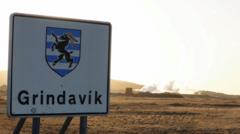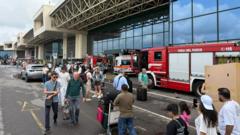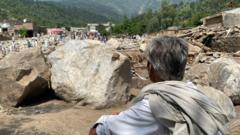A volcanic eruption has erupted on the Reykjanes Peninsula in southwestern Iceland, beginning at approximately 09:45 local time (10:45 BST), just north of the small town of Grindavík. The Icelandic Meteorological Office (IMO) reported that within an hour of the eruption starting, the fissure had widened to an impressive 700 meters (2,296 feet) and continued to grow.
The eruption followed a surge of seismic activity, with hundreds of earthquakes affecting Sundhnúks Crater Row around 06:30 local time. Grindavík and the nearby Blue Lagoon spa, a hotspot for visitors, were preemptively evacuated to ensure public safety. Although road access to the town remains restricted, airline services continue uninterrupted at this time.
As of 11:00 local time, the fissure was noted to extend southward, leading to the emergence of additional cracks. Officials have reiterated the urgency for anyone still in Grindavík to evacuate promptly. Reports from Icelandic media suggest that earlier evacuees included residents who, despite the imminent danger, chose to stay.
The police chief of the region, Úlfar Lúðvíksson, stated that only around 40 homes are currently occupied, following a prior permanent evacuation of most of Grindavík's 4,000 residents, which was enacted in November 2023 prior to earlier eruptions in December, January, February, and March of 2024.
The existing magma tunnel spanning 11 km (6.8 miles) has been identified as the largest recorded since November 11, 2023. Based on prevailing wind patterns, the IMO has cautioned that gas emissions from the eruption are expected to drift northeast towards the capital region of Iceland.
Since 2021, the Reykjanes Peninsula has experienced multiple eruptions, marking a significant geological period, as normally, such activity occurs once every 800 years, lasting for decades. Iceland is home to 33 active volcanic systems and straddles the Mid-Atlantic Ridge, the intersection of two immense tectonic plates, making it particularly susceptible to volcanic events.
The eruption followed a surge of seismic activity, with hundreds of earthquakes affecting Sundhnúks Crater Row around 06:30 local time. Grindavík and the nearby Blue Lagoon spa, a hotspot for visitors, were preemptively evacuated to ensure public safety. Although road access to the town remains restricted, airline services continue uninterrupted at this time.
As of 11:00 local time, the fissure was noted to extend southward, leading to the emergence of additional cracks. Officials have reiterated the urgency for anyone still in Grindavík to evacuate promptly. Reports from Icelandic media suggest that earlier evacuees included residents who, despite the imminent danger, chose to stay.
The police chief of the region, Úlfar Lúðvíksson, stated that only around 40 homes are currently occupied, following a prior permanent evacuation of most of Grindavík's 4,000 residents, which was enacted in November 2023 prior to earlier eruptions in December, January, February, and March of 2024.
The existing magma tunnel spanning 11 km (6.8 miles) has been identified as the largest recorded since November 11, 2023. Based on prevailing wind patterns, the IMO has cautioned that gas emissions from the eruption are expected to drift northeast towards the capital region of Iceland.
Since 2021, the Reykjanes Peninsula has experienced multiple eruptions, marking a significant geological period, as normally, such activity occurs once every 800 years, lasting for decades. Iceland is home to 33 active volcanic systems and straddles the Mid-Atlantic Ridge, the intersection of two immense tectonic plates, making it particularly susceptible to volcanic events.


















